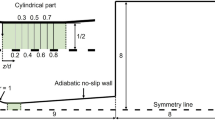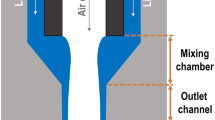Abstract
A numerical investigation is done to study the influence of droplet collisions on the characteristics of hollow cone sprays when subjected to a crossflowing stream of air. The process of hollow cone spray in crossflow is simulated using Eulerian–Lagrangian point parcel spray solver in OpenFOAM platform. Droplet atomization is modelled using LISA–TAB atomization model, and the droplet collisions are accounted using the standard O’Rourke collision algorithm. The numerical simulations are performed to study the effect of crossflow velocity on the hollow cone spray by varying the liquid to gas momentum flux ratio in the range 17,435–213,587. Qualitative and quantitative comparison is made between the spray with collision model and without collision model. The spray characteristics such as Sauter mean diameter (SMD), maximum droplet diameter and length of penetration are reported in the current study. A significant difference in the SMD is observed between the spray with and without collision model. For all the crossflow velocity cases studied, the droplet dispersion is observed to be higher for spray with droplet collisions accounted compared to the spray without accounting collision interactions.


















Similar content being viewed by others
Abbreviations
- \({C}_{\mathrm{d}}\) :
-
Drag coefficient
- \(d\) :
-
Diameter of nozzle (mm)
- \({F}_{\mathrm{D}}\) :
-
Drag force
- \({F}_{\mathrm{g}}\) :
-
Gravity force
- \(\kappa\) :
-
Turbulence kinetic energy
- \(Q\) :
-
Liquid to air momentum flux ratio
- \({\mathrm{Re}}_{\mathrm{p}}\) :
-
Particle Reynolds number
- \(u\) :
-
Continuous phase velocity
- \(t\) :
-
Time
- \({V}_{\mathrm{p}}\) :
-
Droplet velocity (m/s)
- \(\mathrm{We}\) :
-
Weber number
- ε :
-
Energy dissipation rate
- \(\rho\) :
-
Density (kg/m3)
- \(\sigma\) :
-
Surface tension (N/m)
- μ eff :
-
Effective viscosity (kg/ms)
- \(\mathrm{a}\) :
-
Air
- l:
-
Liquid
- p:
-
Particle
- CVP:
-
Counter rotating vortex pair
- LISA:
-
Linearized instability sheet atomization
- SMD:
-
Sauter mean diameter (µm)
- TAB:
-
Taylor analogy breakup
References
Tambe S, Jeng S-M, Mongia H, Hsiao G (2005) Liquid jets in subsonic crossflow. In: 43rd AIAA aerospace sciences meeting and exhibit, p 731
Ghenai C, Sapmaz H, Lin C-X (2009) Penetration height correlations for non-aerated and aerated transverse liquid jets in supersonic cross flow. Exp Fluids 46:121–129
Prakash RS, Sinha A, Tomar G, Ravikrishna RV (2018) Liquid jet in crossflow–effect of liquid entry conditions. Exp Therm Fluid Sci 93:45–56
Song Y, Hwang D, Ahn K (2017) Effect of orifice geometry on spray characteristics of liquid jet in cross flow. In: 55th AIAA aerospace sciences meeting, p 1961
Herrmann M (2010) Detailed numerical simulations of the primary atomization of a turbulent liquid jet in crossflow. J Eng Gas Turbines Power 132:061506
Bravo LG, Kim D, Ham F, Kerner KA (2018) High fidelity simulations of primary breakup and vaporization of liquid jet in cross flow (JICF). In: 2018 Joint propulsion conference, p 4683
Wen J, Hu Y, Nakanishi A, Kurose R (2020) Atomization and evaporation process of liquid fuel jets in crossflows: a numerical study using Eulerian/Lagrangian method. Int J Multiph Flow 129:103331
Nouri JM, Whitelaw JH (2007) Gasoline sprays in uniform cross flow. At Sprays 17:621–640
Johansson P, Sjunnesson A, Olovsson S (1994) Development of an experimental LPP gas turbine combustor. In: International gas turbine and aeroengine congress and exposition
Ashgriz N (2011) Instability of liquid sheets. In: Ashgriz N (ed) Handbook of atomization and sprays. Springer, Berlin, pp 75–96
Saha A, Lee JD, Basu S, Kumar R (2012) Breakup and coalescence characteristics of a hollow cone swirling spray. Phys Fluids 24:124103
Migliaccio M, Montanaro A, Beatrice C et al (2017) Experimental and numerical analysis of a high-pressure outwardly opening hollow cone spray injector for automotive engines. Fuel 196:508–519
Sun Y, Alkhedhair AM, Guan Z, Hooman K (2018) Numerical and experimental study on the spray characteristics of full-cone pressure swirl atomizers. Energy 160:678–692
Ding JW, Li GX, Yu YS, Li HM (2016) Numerical investigation on primary atomization mechanism of hollow cone swirling sprays. Int J Rotating Mach 2016:1–11
Hassani MA, Elkaie A, Shafaee M (2019) Numerical investigation of the full-cone spray structure and characteristics provided by a jet-swirl atomizer. Proc Inst Mech Eng Part G J Aerosp Eng 233:5788–5800
Gao J, Jiang D, Huang Z, Wang X (2005) Experimental and numerical study of high-pressure-swirl injector sprays in a direct injection gasoline engine. Proc Inst Mech Eng Part A J Power Energy 219:617–629
Shim YS, Choi GM, Kim DJ (2008) Numerical and experimental study on hollow-cone fuel spray of highpressure swirl injector under high ambient pressure condition. J Mech Sci Technol 22:320–329
Bafekr SH, Shams M, Ebrahimi R, Shadaram A (2011) Numerical simulation of pressure-swirl spray dispersion by using Eulerian–Lagrangian method. J Dispers Sci Technol 32:47–55
Lain S, Sommerfeld M (2020) Influence of droplet collision modelling in Euler/Lagrange calculations of spray evolution. Int J Multiph Flow 132:103392. https://doi.org/10.1016/j.ijmultiphaseflow.2020.103392
Schmidt DP, Senecal PK (2002) Improving the numerical accuracy of spray simulations. SAE Tech Pap 111:1826–1835. https://doi.org/10.4271/2002-01-1113
Luret G, Menard T, Berlemont A et al (2010) Modeling collision outcomes in moderately dense sprays. At Sprays 20:251–268
Bazdidi-Tehrani F, Abedinejad MS, Mohammadi M (2019) Analysis of relationship between entropy generation and soot formation in turbulent kerosene air/jet diffusion flames. Energy Fuels 33:9184–9195
Bazdidi-Tehrani F, Abedinejad MS (2018) Influence of incoming air conditions on fuel spray evaporation in an evaporating chamber. Chem Eng Sci 189:233–244. https://doi.org/10.1016/j.ces.2018.05.046
Ghosh S, Hunt JCR (1998) Spray jets in a cross-flow. J Fluid Mech 365:109–136
Deshpande SS, Gao J, Trujillo MF (2011) Characteristics of hollow cone sprays in cross flow. At Sprays 21:349–361
Bai B, Sun H, Zhang H, Liu L (2011) Numerical study on turbulent mixing of spray droplets in cross flow. J Propuls Power 27:132–143
Zhang H, Bai B, Liu L et al (2013) Mixing of hollow-cone spray with a confined crossflow in rectangular duct. AIAA J 51:615–622
Zhang H, Bai B, Liu L et al (2013) Droplet dispersion characteristics of the hollow cone sprays in crossflow. Exp Therm Fluid Sci 45:25–33
Zhang H, Bai B (2016) Temperature patterns of air crossflow with hollow-cone spray evaporation. AIAA J 54:3244–3254
Zhang H, Bai B, Wang Y (2018) Quantitative description of droplet dispersion of hollow cone spray in gaseous crossflow. Exp Therm Fluid Sci 93:398–408
Prakash RS, Gadgil H, Raghunandan BN (2014) Breakup processes of pressure swirl spray in gaseous cross-flow. Int J Multiph Flow 66:79–91
Lee S, Kim W, Yoon W (2010) Spray formation by a swirl spray jet in low speed cross-flow. J Mech Sci Technol 24:559–568. https://doi.org/10.1007/s12206-009-1222-6
Salewski M, Fuchs L (2007) Consistency issues of Lagrangian particle tracking applied to a spray jet in crossflow. Int J Multiph Flow 33:394–410
Rüger M, Hohmann S, Sommerfeld M, Kohnen G (2000) Euler/Lagrange calculations of turbulent sprays: the effect of droplet collisions and coalescence. At Sprays 10:47–81
Pan Y, Suga K, Nikolopoulos N et al (2016) High fidelity simulations of binary collisions of liquid drops. Phys Fluids 17:4160–4174. https://doi.org/10.1063/1.2009527
Chowdhary S, Reddy SR, Banerjee R (2020) Detailed numerical simulations of unequal sized off-centre binary droplet collisions. Int J Multiph Flow 128:103267
Qian J, Law CK (1997) Regimes of coalescence and separation in droplet collision. J Fluid Mech 331:59–80
O’Rourke PJ (1981) Collective drop effects in vaporizing liquid sprays. Princeton University, Princeton
Ko GH, Ryou HS (2005) Modeling of droplet collision-induced breakup process. Int J Multiph Flow 31:723–738
Munnannur A, Reitz RD (2007) A new predictive model for fragmenting and non-fragmenting binary droplet collisions. Int J Multiph Flow 33:873–896
Schmidt DP, Rutland CJ (2000) A new droplet collision algorithm. J Comput Phys 80:62–80. https://doi.org/10.1006/jcph.2000.6568
Gavaises M, Theodorakakos A, Bergeies G, Brenn G (1996) Evaluation of the effect of droplet collisions on spray mixing. Proc Inst Mech Eng Part C J Mech Eng Sci 210:465–475
Santolaya JL, García JA, Calvo E, Cerecedo LM (2013) Effects of droplet collision phenomena on the development of pressure swirl sprays. Int J Multiph Flow 56:160–171
Launder BE, Spalding DB (1983) The numerical computation of turbulent flows. In: Patankar SV, Pollard A, Singhal AK, Pratap Vanka S (eds) Numerical prediction of flow, heat transfer, turbulence and combustion. Elsevier, Amsterdam, pp 96–116
OpenFOAM (2016) Programmer’s guide
Crowe C, Schwarzkopf JD, Sommerfeld M, Tsuji Y (1998) Multiphase flows with droplets and particles, 2nd edn. Taylor and Francis, Milton Park
Dombrowski N, Johns WR (1963) The aerodynamic instability and disintegration of viscous liquid sheets. Chem Eng Sci 18:203–214
O’Rourke PJ, Amsden A (1987) The TAB method for numerical calculation of spray droplet breakup. SAE Tech Pap. https://doi.org/10.4271/872089
Lee MW, Park JJ, Farid MM, Yoon SS (2012) Comparison and correction of the drop breakup models for stochastic dilute spray flow. Appl Math Model 36:4512–4520. https://doi.org/10.1016/j.apm.2012.02.015
Author information
Authors and Affiliations
Corresponding author
Additional information
Technical Editor: Erick Franklin.
Publisher's Note
Springer Nature remains neutral with regard to jurisdictional claims in published maps and institutional affiliations.
Rights and permissions
Springer Nature or its licensor (e.g. a society or other partner) holds exclusive rights to this article under a publishing agreement with the author(s) or other rightsholder(s); author self-archiving of the accepted manuscript version of this article is solely governed by the terms of such publishing agreement and applicable law.
About this article
Cite this article
Reddy, C.C., Chowdhary, S., Nimmagadda, R. et al. Droplet breakup and coalescence characteristics of hollow cone spray in crossflow. J Braz. Soc. Mech. Sci. Eng. 45, 169 (2023). https://doi.org/10.1007/s40430-023-04082-4
Received:
Accepted:
Published:
DOI: https://doi.org/10.1007/s40430-023-04082-4




